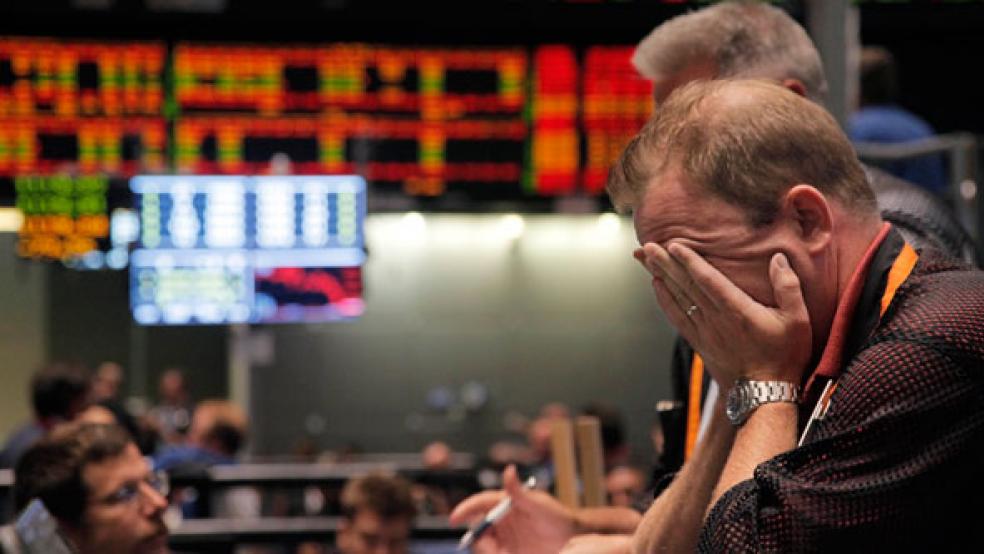For weeks, as stock market analysts eyed the prospect of a ratings downgrade for U.S. debt, we repeatedly heard that the consequences would be unclear because a world in which the United States has anything other than a AAA credit rating would be uncharted territory. As it turns out, that uncharted territory can be hazardous to your portfolio.
Accelerating a slide that began two weeks ago, Wall Street on Monday suffered its worst day since the financial crisis of 2008. The Dow Jones Industrial Average plunged 5.6 percent to 10,809.85. The drop of 634.76 points was the sixth worst ever. The NASDAQ dropped 174.72 points—6.9 percent—to 2,357.69. In addition, the S&P 500 fell 79.92 points, or 6.7 percent, to 1,119.46. It has plunged 11 percent in three days— the fastest such drop since late 2008. Perhaps most remarkably, all 500 stocks in the index finished the day with losses. As the trading session neared its close, Jason Goepfert of Sundial Capital Research pointed out the historic breadth of the selloff, noting that the last time the market was so universally awash in red was in May 1940. “Yes, it's been 70 years since it has been this bad,” he wrote.
“We're seeing several breadth- and price-based indications that today is, in effect, a market crash. By that, I mean that the level of selling pressure is so great that we've witnessed something similar only a handful of times, and they were what most consider to be crashes or at least mini-crashes.”
Monday’s tumble places all three indexes within sight of bear market territory, or losses of 20 percent from their recent highs. The Dow is off 15.6%, while the NASDAQ and S&P 500 are have lost nearly 18 percent. The S&P has seen $2.2 trillion in value erased since its April 29 peak.
The Russell 2000 Index of small companies has already entered bear territory, with its 8.9 percent plunge Monday leaving it 25 percent below its April high. European stocks have also been mauled by the bear, as the Stoxx Europe 600 Index has now tumbled 21 percent from the high reached on February 17.
For more than two years, Wall Street blithely powered higher even as the economy struggled to regain momentum following the financial crisis of 2008. The Standard & Poor’s 500-stock index more than doubled from March 2009 to April of this year. But with the global recovery teetering, investors have been forced to acknowledge an increasingly gloomy economic outlook and may be suffering a crisis of confidence that solutions will be found. Given the drumbeat of weak economic data at home and a spiraling debt crisis in Europe, some investors have concluded that stimulus spending and loose monetary policy have failed to spur the strong economic growth that had previously been forecast for the second half of the year. “The two arrows that are in the quiver didn’t work. I think the market’s now scratching its head, saying, well, what’s next?” says Daniel Alpert, managing director of Westwood Capital in New York.
A key measure of market fear, the Chicago Board Options Exchange Volatility Index or VIX, soared 46 percent Monday, a sign that investors believe more turbulence lies ahead. “It’s really hard to handicap at what level this stops,” says Mike Norman, chief economist at John Thomas Financial in New York.
Yet some optimistic investors believe stocks are getting cheap. “We are wasting a terrific earnings season with 61 percent of the companies reporting beating estimates, while 68 percent beat revenue estimates,” Jeff Saut, chief investment strategist at Raymond James, wrote in a Monday morning research note. “Moreover, I think the recent rout is more about the aforementioned ‘Crisis of Confidence’ environment than the fundamentals. To be sure, as of yet there is no economic evidence the country is sliding into recession -- slow growth, yes; recession, no.”
Just as in Washington, those on Wall Street are debating what needs to be done to prevent further economic deterioration—and where stocks could be headed, depending on which policies are implemented. David Kostin, chief investment strategist at Goldman Sachs, on Monday cut his year-end target for the S&P 500 from 1,450 to 1,400—a level that’s still 25 percent above where the index closed Monday.
But if no effective solutions are found and the new austerity measures sap any remnants of growth, Norman of John Thomas Financial offers a sobering thought about the possible downside. “There’s no reason that the market can’t go back down to the lows we saw in 2009. That’s not out of the question.” In March of that year, the S&P 500 hit 676.53—nearly 500 points below its Monday close. “It’s hard to say where it’s going to stop because we’ve never been in a situation like this before, at least not in a post 1930s economy,” Norman says. Or as we keep hearing, we’re in uncharted territory.





